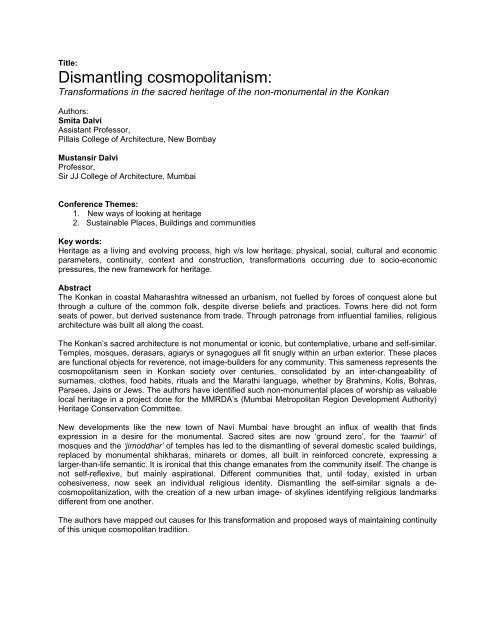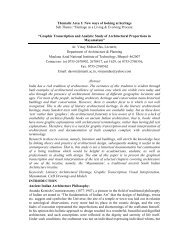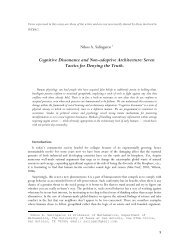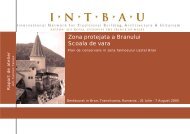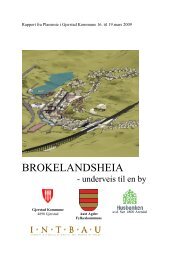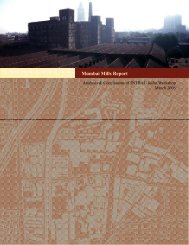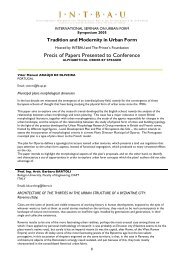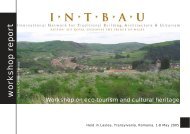S. Dalvi - Intbau
S. Dalvi - Intbau
S. Dalvi - Intbau
Create successful ePaper yourself
Turn your PDF publications into a flip-book with our unique Google optimized e-Paper software.
Title:Dismantling cosmopolitanism:Transformations in the sacred heritage of the non-monumental in the KonkanAuthors:Smita <strong>Dalvi</strong>Assistant Professor,Pillais College of Architecture, New BombayMustansir <strong>Dalvi</strong>Professor,Sir JJ College of Architecture, MumbaiConference Themes:1. New ways of looking at heritage2. Sustainable Places, Buildings and communitiesKey words:Heritage as a living and evolving process, high v/s low heritage, physical, social, cultural and economicparameters, continuity, context and construction, transformations occurring due to socio-economicpressures, the new framework for heritage.AbstractThe Konkan in coastal Maharashtra witnessed an urbanism, not fuelled by forces of conquest alone butthrough a culture of the common folk, despite diverse beliefs and practices. Towns here did not formseats of power, but derived sustenance from trade. Through patronage from influential families, religiousarchitecture was built all along the coast.The Konkan’s sacred architecture is not monumental or iconic, but contemplative, urbane and self-similar.Temples, mosques, derasars, agiarys or synagogues all fit snugly within an urban exterior. These placesare functional objects for reverence, not image-builders for any community. This sameness represents thecosmopolitanism seen in Konkan society over centuries, consolidated by an inter-changeability ofsurnames, clothes, food habits, rituals and the Marathi language, whether by Brahmins, Kolis, Bohras,Parsees, Jains or Jews. The authors have identified such non-monumental places of worship as valuablelocal heritage in a project done for the MMRDA’s (Mumbai Metropolitan Region Development Authority)Heritage Conservation Committee.New developments like the new town of Navi Mumbai have brought an influx of wealth that findsexpression in a desire for the monumental. Sacred sites are now ‘ground zero’, for the ‘taamir’ ofmosques and the ‘jirnoddhar’ of temples has led to the dismantling of several domestic scaled buildings,replaced by monumental shikharas, minarets or domes, all built in reinforced concrete, expressing alarger-than-life semantic. It is ironical that this change emanates from the community itself. The change isnot self-reflexive, but mainly aspirational. Different communities that, until today, existed in urbancohesiveness, now seek an individual religious identity. Dismantling the self-similar signals a decosmopolitanization,with the creation of a new urban image- of skylines identifying religious landmarksdifferent from one another.The authors have mapped out causes for this transformation and proposed ways of maintaining continuityof this unique cosmopolitan tradition.
Dismantling cosmopolitanism:Transformations in the sacred heritage of the non-monumental in the KonkanThe main findings described in this paper are the result of a project called‘Navi Mumbai (Raigad) Heritage Project 1 :Identification, listing and grading of structures and precincts of cultural, historical orarchitectural importance that merit heritage conservation in Navi Mumbai notified area, whichfalls under district Raigad’.This project was completed in April 2006 and submitted to the MMRDA’s (MumbaiMetropolitan Region Development Authority) Heritage Conservation Committee. The project setdown guidelines for preservation specific to the identified structures in Panvel, Uran andsurrounding villages in Raigad district in the Konkan. It is from this region that this paperderives its case studies in transformation of the sacred heritage of the non-monumentalarchitecture. In addition several examples from other parts of the Konkan shall be cited forcomparison.The KonkanThe Konkan includes Thane, Greater Bombay, Raigad, and Ratnagiri and Sindhudurg districts.Raigad forms the historic region of western India, immediately south of Bombay. In Raigad,Uran and Panvel are the main urban centers, and Alibag is a district center. Raigad on theKonkan established foreign trading ports with Greece as early as the 3rd century BC. In the 17thcentury it became a Maratha stronghold. With the advent of the Portuguese and British, the portcities were further developed, yet now have lost their former importance. In the 70s, NewBombay (Navi Mumbai) was carved out of existing districts Raigad and Thane. Navi Mumbaiwas developed as a complete self-contained new township across the harbor from the MumbaiMetropolis.Navi MumbaiAlthough popular belief has it that the area was tabula rasa, the reality is that the areasappropriated to form the new city are historically significant to the development of WesternMaharashtra. The Towns of Panvel and Uran, within the Navi Mumbai Notified Area in factpredate Mumbai in historical vintage. There are several significant sites in the region dating backfrom the early eighteenth century at the peak of the Peshwahi period, and building activityflourished through to the time of Indian Independence. These reflect the constructive genius ofthe original inhabitants.Panvel and UranThe historic settlement of Panvel is 300-years old, developed around trade routes (both land andsea), during the time of Maratha/ Portuguese/British dominance of the Konkan region. Duringthis time, building activity in these townships was generated by the affluence due to trade. Thiscan be seen in the large Wadas and the buildings that came up during the relative affluence of thePeshwahi and post-Peshwahi period. Uran is a more contemporary name given to Karanja,formerly an island, or ‘Bet’. Uran’s unique context is that of a harbor whose use dates back to theMauryas and Silharas. The waters around Uran have been witness to several sea battles betweenthe Marathas, the Portuguese and the British.
The Patronage of families- the culture of the common folkThe social/religious structure in the towns of Panvel and Uran was/is eclectic. There are largepopulations of Hindus, Bohras and Jains who form the trading communities. There used to be asignificant presence of Bene- Israeli Jews, but these have dwindled over recent times. Theimpetus of trade and the social pro-activeness of its trader families made towns like Panvel andUran market centers. Several influential families made important contributions over the last threehundred years to the creation of an urban image. These were either merchants or families withadministrative clout.These affluent families like The Bapats, the Gulves, the Puraniks, the Banthias, the Parmars, theMunots the Bhaijis and the Tungekars seamlessly plugged into the extant traditions, enhancingthem with their wealth and continuing older values. They became the patrons and city fathers,building mosques, temples, derasars and water tanks for public use, not as kings showeringlargesse, but as citizens participating in the communal processes of urban life. In the processthey created several “cool town centers, for both sacred and social uses” (Heschong, 1990), thatstill exist, if only precariously, today. Many of the structures built under their patronage and stillcarry associations of local history and collective memory. “All urban communities, whether theyhave developed gradually over time or have been created deliberately are an expression of thediversity of societies throughout history.” (ICOMOS, 1964) The fact that the larger locations ofPanvel and Uran on this part of the coast did not form any seat of power, but derived theirsustenance from trade and transport, points to the domestic nature of their sacred sites. Thesereligious structures are indicative of the public projects in the towns, of greater patronage fromthe wealthy citizens and spaces for community participation.Sacred architecture- the monumental and the domesticThere are two discernable types of sacred architecture in the Konkan. Certain temples andmosques display a monumental character, and are significant in their presence over the cityskyline. Monumental temples display the Peshwahi or Maratha style, which combine the featuresof Dravidian and Islamic style in a graceful synthesis, especially in the stucco articulation of theshikhara and in the interiors. The Shikharas of these temples tower over the surroundinglandscape forming landmarks in the skyline. Islamic architecture displays the Deccani style,emphasized by bulbous masonry domes, either over the prayer halls or the tomb chamber inDargahs. Such sites, although located strategically, are few in numberFigure 1. The ‘monumental’ Ballaleshwar Mandir, Panvel and the ‘domestic’ VirupakshaMandir, Panvel
Far more ubiquitous and pervasive is the non-monumental sacred architecture following adomestic scale. It is this second type that creates the urban fabric of the towns of the Konkan.This cuts across religious lines. Most part privately built places of worship display a typical formof construction associated with the Konkan. This typology has emerged out of locally availablebuilding materials and building/craft practices, and responds to the climate of the Konkan. Thenon-monumental, privately built places of worship display typical Konkan style timber frameconstruction with sloped roofs, detailed with open fronts of TW framework with infill. Thistypology has emerged out of local materials, craftsmanship and climate. As such they share suchcharacteristics with the domestic architecture also predominant in these towns. The domestictypologies in the Konkan are1. Wadas: courtyard houses with timber frame construction, typifying a particular way oflife.2. Muslim houses with front verandahs and highly ornate neo-Baroque features on facades,sometimes combined with vernacular features in timber.3. Colonial Bungalows adapted to a local lifestyle.Figure 2. Domestic Architecture- Wadas of PanvelA cosmopolitan self-similarityThe Domestic scale is significant in the way it is reworked into the design of the sacredstructures. When built, irrespective of religious denomination, they take from the buildingtraditions of the domestic houses, built of timber construction and deep sloping roofs, fitting inneatly within the residential fabric of the townscape.These buildings are truly non-iconic, giving no overt symbols of faith and one could be easilymistaken for another. It is only in the interior spaces that the accoutrements of religious ritualshow the places to be what they really are- mosques, temples, derasars, agiarys or synagogues.Sacred architecture in Navi Mumbai is best read in continuity with similar sites all over this partof the Konkan in that they reveal a non monumental, non iconic aspect, that it is at oncecontemplative, urbane and self similar.
Figure 3. The Jami Masjid, Owe; The Ramdas Maruti Mandir, Panvel and the Beth-ElSynagogue, PanvelThese modest structures stand as functional objects for active reverence, not as iconic imagebuilders for a particular community. This indicates a remarkable cosmopolitanism seen in thedevelopment of Konkan society over the last two hundred years, with an interchangeability ofsurnames, clothes, food habits and rituals, and the all-pervasive use of Konkani-inflected Marathias the language of public discourse.Case Study- TempleThe Podhi Mandir, in Panvel is a timber frame structure supporting a hipped timber roof.Typically, the entire temple front, instead of having a solid wall, is in the form of timberframework with an infill of vertical MS rod grill. This very traditional Konkan style open fronttemple is organized into a sabha-mandap and a Garbhagriha which are separated by a grill abovethe lintel level, and MS rods below. The sabha-mandap typically is divided into a nave and twoisles along the supporting posts with very low-level wooden railings. It shares all its typologicalfeatures of planning and construction with the Virupaksha Mandir shown above. The temple iselegant and well preserved, a much-loved place of worship.Figure 4 Podhi Mandir, PanvelCase Study- PrecinctThe Deulwadi Precinct in central Uran, has ten temples strung out in a small area, displayingboth a domestic and a monumental scale. The proximity of these many temples makes this area asacred both in its extent and its usage, and is identified by banyan tree, well, deepa stambhas andopen space. The Ganpati chowk with Hanuman Mandir, Ganesh Mandir and Lakshmi Mandirabuts the road on one side and Ram Mandir at the starting point of the busy Bazaar Peth.
Figure 5 The Deulwadi Precinct, UranCase Study- MosqueMosques in the Konkan are mostly built with private initiative. Several features on the mosquesconform to the domestic architecture of the Muslim town houses, ornamented with Islamicelements from Bijapur, as well as Classical elements like Corinthian pilasters. This mix isrepresentative of turn of the century Muslim domestic architecture. The Jami mosque in Uranwas built by Hazrat Shaikh Mulla Husain Tungekar a prominent and wealthy citizen from Uran’sKonkani Muslim Community, and represents, among many other sub-cultures, the contributionof the Konkani Muslims to its development. On the other hand, the mosques at Vijaydurg andAchra, although accorded the status of Friday Mosques, are entirely functional and domestic inscale reflecting on the everyday qualities of practiced faith in its aspect.the aesthetic of the masjidFigure 6. The Jami Masjid, Uran- exterior aspect and interior aestheticFigure 7. The Jami Masjid, Vijaydurg, The Jami Masjid, Achra
Case Study- AgiaryThe Umrigar Agiary in Uran (1904), a ‘Nhallo aatish’ (small fire) was built as a private initiativeby Sheth Kuverji Adelji Umrigar and Sheth Khurshedji Adelji Umrigar. In the beginning of the20 th century 2 there was a sizable presence of Parsi community (around 800) in Uran. Thesefamilies were mainly in the business of distilleries. Presently, only a handful remain.Figure 8. The Umrigar Agiary, Uran and the Jain Derasar, Kapad Galli, PanvelCase Study- DerasarThe Jain Mandir in Panvel’s Kapad Galli is a non-monumental, Town Derasar (Jain Temple),built in timber. The small but influential Jain community mainly consists of merchant families,their houses and shops being either on the same street or in nearby areas. The influential Parmar,Munot, Banthia and Gandhi families came together to construct the much-needed Derasar. 3An unselfconscious syncretismThe cosmopolitanism seen in Kokani society over the last three centuries is reflected in thelifestyle and mores of all Konkanis, whether Brahmin, Koli, Bohra, Dakhani, Parsee, Jain or Jew.In no one community is this displayed better than in the Bene Israelis- the native Jews of theKonkan.The Bene Israelis served variously with the Maratha Angrias, the Siddhis of Janjira and the EastIndia Company (Israel, Date NA). Small pockets of these communities still exist all over theKonkan, although many had migrated to Israel upon its formation. In the 1971 census, there were850 Bene Israelis counted in the Kulaba District. Today, approximately 5,000 live in Bombayand the surrounding towns and villages of Maharashtra (Schwartz, 2003).In the erstwhile Kulaba (now Raigad) District the Bene Israelis are completely integrated withtheir neighbors. Even today they have surnames like Penkar, Divekar or Ashthamkar (identifiedby place names), men have names like Bapuji, Abaji and Tanaji, and women are called Sonabai,Bayna or Ambai. They accepted the traditions and practices of both the Muslims (specially in thesacred- ‘masheed/masjid’ for synagogue and ‘Kazi’ for Rabbi) and of the Hindus (weddingsrituals include the’sakharpuda’ etc).In this day-to-day manner, the Bene Israelis practice an unselfconscious syncretism, which is thehallmark of the Konkan.
Figure 9. Synagogues in Nandgoan, Panvel and RevdandaBetween 1840 and 1896, the Bene Israelis established 12 synagogues all over the Konkan, fromBombay to Revdanda. Few of these are extant and in use today. However, they too display adomestic scale like other sacred spaces in the Konkan. These synagogues are generic examplesof the non-monumental, community built, Konkan style place of worship, in timber constructionreflecting the unique generic pattern of building irrespective of religious affiliations. Built intimber on Brick or laterite masonry, these ‘masheeds’ are identifiable as Jewish only in theaccoutrements of their interiors with the Teba, the Hechal and the Tamid.The Beth-El Synagogue was built in 1849 on Panvel’s main street. It is well maintained and stillin active use today with several faithful visiting it from the region and even abroad. Far less welllooked after is the Jewish Burial Ground in Panvel occupying a small plot with mainly neglectedgraves. The presence of this burial ground is an indication of the presence and the socialsignificance of the members of the Jewish community in Panvel in the 19 th and the first half ofthe 20 th century. Many tombstones and cenotaphs bear inscriptions in three languages, Hebrew,English and Marathi simultaneously. A few older looking tombstones however bear inscriptionsonly in Hebrew. The names suggest that the Jewish people here had adopted Marathi surnames,like ‘Bension Solomon Bhoparkar’ or ‘Sasoon M. Khandalkar’. There is a significant epitaph inMarathi on a tombstone addressed “Dear Husband…. 4 ” In a poetic vein, the wife compares herhusband with ‘Ek-vachani Ram’ and ‘Gangajal’ and seeks God’s blessing for the same husbandfor next seven births. The inscription is signed by one Ruby-Bai Benjamin Chincholkar.The example of the Bene Israelis is replicated in the traditions of several other communities inthe region. The covert syncretism forms the binding glue that holds the community together. Thisis further embedded in the structures created by these communities, from abodes to places ofworship. Public life and the public aspect of buildings emerged over several generations ofunchanging existence and got concretized. Change was slow in coming, but as in the case ofPanvel and Uran, when it did, its was fast, and is irreversible.The palimpsest of Navi MumbaiNavi Mumbai came as an external project palimpsest on this extant situation. A project not of themaking of local inhabitants but that of Bombay, across the pond, as it were, that kick-started theaccretion of knowledge and urbanization, brought in change at a pace unimagined before andover thirty years engulfed two municipal councils older than Bombay. This is not to say that thechange has been negative. This part of the Konkan has been deprived of development ascompared to the other parts of Maharashtra and the project of New Bombay plugged the Konkan
into the larger process of development of Maharashtra. This has brought with it affluence,affordability an increased spending power that has changed desires and aspirations.Figure 10. The remains of an earlier townscape, and the challenge of RCCSites of contest and revisionThe rate of change in Municipal towns is unregulated and largely ad-hoc. This has led to theinevitable proliferation of RCC framed multi-storey buildings that are, very quickly, changingsuch towns that have a composed face to start with. Scale, construction, technology and aspectare fast transforming the towns that had hitherto developed slowly. As in every area surroundinga metropolis like Mumbai, Panvel and Uran too are pies being subdivided by the builder’slobbies for speculation and profit. In such places only heritage legislation may stand between theolder urban character and contemporary anonymity. The builders target plots in the middle oftowns and those of the largest size.Thus the older large and sprawling wadas in these towns that formed the rich backdrop ofcommunity life are now under threat of being lost forever. The current owners of the wadas, whoface high costs trying to maintain these large spaces, feel compelled to let go their estates for thelarge sums the builders offer them. The busy roads on which these wadas abut that are scaled tothese G+1 structures, now become scale-less when G+4 buildings tower over these narrowstreets. The fact that these new constructions are patronized by the citizens without muchresistance are indicative of upward mobility and a lifestyle based on cities much larger thanPanvel and Uran.Dismantling the cosmopolitan- seeking new identitiesOne manifestation of this is to upgrade one’s living condition and environment, at least asperceived by the community. This has led for the different communities in the Konkan, whichuntil this point existed in an urban cohesiveness, to seek an identity in their structures that nowrepresent individual religious identity and not the social identity that was for long its hallmark.The influx of wealth also expresses itself in the desire for the monumental. Thus sacred sites arenow ‘ground zero’ for these expressions. The ‘tamir’ of mosques and the ‘jirnoddhar’ of templeshas led to the dismantling of several domestic scaled buildings to be replaced by the monumentalshikharas, minarets or domes all built in the technology of reinforced concrete, all expressing alarger than life semantic, quite without aesthetic precedent, where big is big for its own sake.
Figure 11. Hanuman Mandir, Panvel- before and after ‘Jirnoddhar’Figure 12. The Virupaksha Mandir, Panvel- then and nowAspirations driving changeThe irony here is that this change is emanating from the community itself. The attitude here isnot self-reflexive, but mainly aspirational. The community is at ease with these changes. Whathas become irrevocable is that the image of the city is being transformed into one where theskyline now clearly identifies the new changes as religious landmarks that are visibly differentfrom one another. The dismantling of the older non-monumental self-similar structures alsosignals a de-cosmopolitainzation of the small towns of the Konkan, creating a rip through thefabric of urban community.Figure 13. Mosque on M.G. Road, Panvel- Photo from 1993 and today
Most of the non-monumental religious structures most are built in a common unselfconscioustradition that is largely self-similar and cuts across religious lines. It is these characteristics, nowfast disappearing that need a priority in preservation.The case for controlled changeOne point in the favor of controlled change is that the models for change may come from theheritage building themselves. There are clear examples of temples that are G+1 for functionalpurposes that do not detract from the scale consistent with these areas and in fact offer a distincttypology that can be followed whenever the pressures of expansion are evident. In the VinayakMandir at Kegaon, a Ganesh temple built with private initiative, located non-intrusively in thewadi of Kegaon village. Here a timber framed Mangalore hipped roof supported on TW raftersforms an attic level overlooking the main mandapa below. The attic level is formed with TWboarding on TW joists. The front verandah has a lean to roof in timber. Above the garbagriharises a domical shikhara on a drum, but of a scale much smaller than the height of the mandapaitself, which has the aspect of a typical Konkani town house.Figure 14. Vinayak Mandir, KegaonGuidelines for preservationAs part of the ‘Navi Mumbai (Raigad) Heritage Project’ notifications, specific guidelines wereproposed for the non-monumental sacred spaces in terms of possible changes, repairs, additions,alterations and renovations:1. Changes, repairs, additions, alterations and renovations required on religious grounds,mentioned in sacred texts, or as part of holy practices laid down in religious codes shouldbe permitted. These are subject to their being in accordance with the original structure,design, aesthetics and other special features.2. Utmost care should be exercised while permitting ‘jirnoddhar’ or ‘tamir’ of the nonmonumental,Konkan style shrines with timber construction; and of temples in Peshwahistyle; in order to preserve the few remaining structures in this styles, their original scaleand aesthetics, in material and detail. The repairs should be carried out, as far as possibleemploying the same material, construction techniques and ornamentation.3. When balance FSI is available on the plot, additional floor space, if desired, may beadded to a ground storey shrine by introducing an upper storey. This should be done bycarefully dismantling the existing timber roof and putting it back on the upper storey. Theupper storey should be constructed in the same construction style, fenestration design andmaterials as the lower storey. As far as possible all existing elements should be reused.4. Addition or Reconstruction involving more than ground plus one upper storey should notbe permitted.
Heritage Conservation and Fast KnowledgeThe issue of heritage conservation has developed a keener resonance in the era of fastknowledge. Heritage legislation breathes easier in an environmental stasis, when buildings soidentified continue to remain so and only face the natural structural ravages of time. It is whenthe buildings are fore grounded in the identity and aspiration of its users or the community atlarge that change, such as it is, is inevitable, and the old is constantly under pressure to give wayto the new. This is where the issue of preservation through legislation comes into direct conflictwith its ultimate beneficiaries.In the Raigad district, as in the rest of the Konkan, the issues of continuity and change areconfronted, rather awkwardly. The processes of change depend on whose point of view is beingtaken. The several points of view, though legitimate in themselves sit side by side uneasilywherethe first step in addressing one point of view would be to the perceived detriment of theother. Here, the sacred sites reflect both the need to preserve, as well as for the local communitythe desire to change.Whereas one cannot make a case for up-gradation to stop merely by putting these building in alist and legislating, the heritage gets a much better chance of being conserved by gainingacceptance as ‘one’s own heritage’ within the community itself. Any heritage listing will need asustained programme of awareness creation in order to be successful on the ground.This analysis offers some vital clues whether to conserve such sacred sites and how to go aboutdoing it. A strong case has emerged in favor of their conservation. “Whether the sacred sites arelarge or small, whether they are at the center of the towns, in the neighborhoods, or in thedeepest countryside, establish ordinances which will protect them absolutely- so that our roots inthe visible surroundings cannot be violated.” (Alexander, 1977) Absolute protection calls forspecificity in legislation and notification. When it comes to places traditionally accepted assacred by an entire community, no other method of preservations can be adopted before ensuringthe preservation of such sites by law. Not doing anything will mean a place falls into ruin atnature’s pace. Intervention, if misguided or with malafide intent can destroy heritage overnight.BIBLIOGRAPHY1. Aalekar, Dr. B. (1970) Panvel Shaharatil Mandire. Navakal (Marathi), Daily Edition,May 11.2. Alexander, C., et al. (1977), A Pattern Language, Oxford University Press, N. Y.3. Centenary Souvenir of the Panvel Municipal Council (1957)4. Gazetteer of the Bombay Presidency, Thana dist. Vol XIII, part I (1882)5. Heschong, L. (1990), Thermal Delight in Architecture, the MIT Press.6. International Charter For The Conservation And Restoration Of Monuments And Sites(ICOMOS) (1964)7. Israel, B. (date NA), The Bene Israel of India, OUP.8. Schwartz, B. (2003) India’s Bene Israel, B'nai B'rith Magazine, Summer Edition.From < http://bnaibrith.org/pubs/bnaibrith/2003_sum__india.cfm?india=3 >(Retrieved December 10 2007)9. Uran Municipal Council, Centenary Celebration Volume (1987)
NOTES1 The Navi Mumbai (Raigad) Heritage Project was funded by the MMRDA, carried out by Smita<strong>Dalvi</strong> (Project Supervisor) and her team from Pillais College of Architecture, Panvel.2 Plaque on the verandah of the Agiary & conversation with the present caretaker, Mr. Kersi Sui3 Conversation with Shri Lalchand Parmar, a trustee4 The entire Chincholkar epitaph (translated from Marathi) reads as follows:Benjamin Aaron Chincholkar (mechanic)B. 1910 D. 1983“Beloved husband,You have made the great leap in the skyto the other side.Without you I cannot recognize myself.You were caring, and steadfast like Rama,who kept his singular vow,and all that I have left nowIs the memory of your name.Whatever you said turned out trueand I can only recollect those experiences.You loved your children beyond compare,that love is left with us.I have never stopped reminiscing,all that was good about you,pure as the Ganges,I ask for you in all my later lives.This is all the blessing I ask from the almighty.”Your wifeRuby-bai Benjamin Chincholkar


